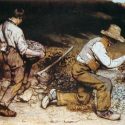10 Most Famous Self-Portraits of Art History
Self-portraits have been a captivating genre in the art world, offering a glimpse into the minds of the artists themselves. In this article, we will delve into the world of self-portraiture and explore the 10 Most Famous Self-Portraits in Art History.
In the hallowed halls of art history, self-portraits stand as intimate windows into the souls of the artists who dared to capture their essence on canvas. These introspective masterpieces are not mere reflections; they are profound narratives, each brushstroke echoing the artist’s innermost thoughts, struggles, and triumphs.
Join us on a mesmerizing odyssey through time and creativity as we uncover the enigma behind the 10 Most Iconic Self-Portraits in Art History. As we traverse the diverse landscapes of artistic expression, we will unravel stories that span centuries, cultures, and emotions. Each self-portrait is a testament to the artist’s ability to confront their image, gaze into the mirror of selfhood, and immortalize their unique essence in pigment and form.
In this illuminating exploration, we will not only admire the technical brilliance of these self-representations but also decipher the profound symbolism, the hidden emotions, and the artistic daring that define them. From da Vinci’s mysterious smile to Kahlo’s unyielding gaze, these portraits are more than depictions; they are profound meditations on identity, mortality, and the very nature of art itself.
Furthermore, our journey will take a deep dive into the tortured brilliance of Vincent van Gogh, exploring the heart-wrenching depths of his psyche through his iconic work, ‘Self-Portrait with Bandaged Ear.’ This haunting painting, born from the artist’s profound despair and yet pulsating with raw vitality, serves as a poignant reminder of the artist’s ability to transform pain into art.
So, step into the galleries of history with us. Let us unravel the stories that lie within the eyes, the gestures, and the expressions of these artists. Let us celebrate the audacity of self-exploration and the enduring power of self-portraiture. Through our exploration, we will not only witness the evolution of artistic styles but also gain a profound understanding of the human spirit—one that transcends time, canvas, and brush, leaving an indelible mark on the very fabric of art history.
10 Most Iconic Self-Portraits in Art History
10- Vincent van Gogh – Self-Portrait with Bandaged Ear (1889)
Vincent van Gogh’s self-portraits are windows into the mind of a tortured genius, and perhaps none are more poignant than his “Self-Portrait with Bandaged Ear,” painted in 1889.
The creation of this self-portrait was preceded by a dramatic event. In December 1888, Vincent van Gogh suffered a severe mental breakdown, culminating in a moment of desperation where he famously severed part of his ear with a razor blade. Despite this immense personal struggle, van Gogh continued to paint, channeling his pain and emotions onto the canvas.
Recommended For You – Self-Portrait with Bandaged Ear Analysis

Self-Portrait with Bandaged Ear, 1889 by Vincent van Gogh – 10 Most Famous Self-Portraits of Art History.
“Self-Portrait with Bandaged Ear” is more than just a painting; it is a testament to the strength of the human spirit and the transformative power of art. In this work, Vincent van Gogh‘s pain and resilience are immortalized, inviting viewers to contemplate the depths of human emotion and the enduring legacy of one of history’s most celebrated artists.
9- Frida Kahlo – Self-Portrait with Thorn Necklace and Hummingbird (1940)
Frida Kahlo, a pioneering Mexican artist, is renowned for her powerful and emotive self-portraits. Among her many masterpieces, “Self-Portrait with Thorn Necklace and Hummingbird,” painted in 1940, stands out as a testament to her resilience and creativity despite immense physical and emotional pain.
In this self-portrait, Kahlo presents herself against a vibrant, leafy background, wearing a thorn necklace that pierces her neck, drawing a few drops of blood. Around her neck, a hummingbird is perched, its delicate wings vivid against the backdrop of her flowing hair.

Self-Portrait with Thorn Necklace and Hummingbird, 1940 by Frida Kahlo – Harry Ransom Center, Austin – 10 Most Famous Self-Portraits of Art History.
Recommended For You – Frida Kahlo’s “Self-Portrait with Thorn Necklace and Hummingbird” Analysis
Kahlo’s intense gaze and the subtle hint of a smile on her lips add to the painting’s emotional depth. Despite the thorn necklace and the blood, there is a sense of determination and defiance in her expression, emphasizing her unwavering spirit in the face of suffering.
The painting is a striking combination of vivid colors and intricate details, typical of Frida Kahlo’s distinctive style.
“Self-Portrait with Thorn Necklace and Hummingbird” is a powerful embodiment of Frida Kahlo’s artistic genius and her ability to turn personal pain into timeless art. Through this masterpiece, she invites viewers to confront the complexities of the human experience, reminding us of the strength that resides within vulnerability and the transformative power of creativity.
8- Rembrandt van Rijn – Self-Portrait with Two Circles (c. 1665-1669)
Rembrandt van Rijn, a Dutch Golden Age painter, is celebrated for his exceptional skills in capturing the human spirit and depth of emotion in his artworks. “Self-Portrait with Two Circles,” painted between 1665 and 1669, is a testament to his artistic brilliance and introspective gaze.
In this self-portrait, Rembrandt presents himself with a commanding presence. He is depicted wearing a luxurious fur-trimmed coat and a beret, his eyes penetrating and contemplative.
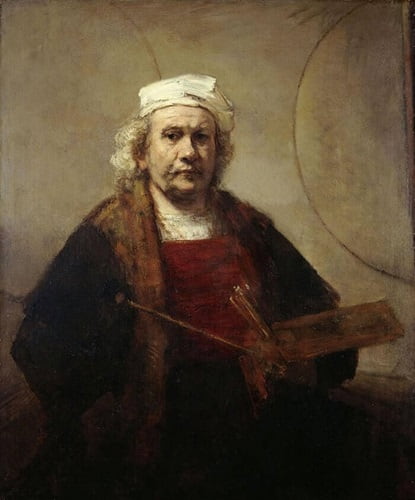
Self-Portrait with Two Circles, 1655-1669 by Rembrandt van Rijn – 10 Most Iconic Self-Portraits of Art History.
The background is dominated by two circles, which have been the subject of much speculation and interpretation among art historians. Some interpretations suggest that they represent the artist’s mastery of the circle, a challenging geometric shape in art. Others speculate that they symbolize Rembrandt’s deep understanding of the cyclical nature of life and art, reflecting themes of eternity and continuity.
“Self-Portrait with Two Circles” exemplifies Rembrandt’s innovative approach to self-portraiture. Unlike traditional self-portraits of the time, Rembrandt’s depiction is introspective and contemplative. His ability to convey a deep sense of introspection and wisdom sets this painting apart as a masterpiece of psychological insight.
“Self-Portrait with Two Circles” is a testament to Rembrandt van Rijn‘s mastery of the artistic craft. Through his use of light, shadow, and symbolism, Rembrandt created a self-portrait that transcends time, inviting viewers to engage with the artist’s introspection and artistic genius.
This painting remains a source of inspiration, reminding us of the transformative power of art to capture the essence of the human soul.
7- Diego Velázquez – Las Meninas (1656)
“Las Meninas,” painted in 1656 by Diego Velázquez, is a pinnacle of Baroque art and a testament to the artist’s extraordinary talent and innovation. This iconic painting not only captures the Spanish royal court but also challenges traditional notions of representation and perception.

Las Meninas, 1656 by Diego Velázquez – 10 Most Famous Self-Portraits of Art History.
At the center of “Las Meninas” stands Infanta Margarita Teresa, surrounded by her ladies-in-waiting, a dog, and various other figures. In the background, a mirror reflects the image of King Philip IV and Queen Mariana. Notably, Velázquez himself is present in the painting, standing behind a large canvas, brush in hand, seemingly in the act of painting the scene before him.
Diego Velázquez‘s inclusion of himself in the painting adds an intriguing layer to “Las Meninas.” By placing himself in the artwork, he blurs the line between reality and representation. His presence challenges the viewer’s perception, raising questions about who the real subject of the painting is: the Infanta, the royal couple in the mirror, or the artist himself.
“Las Meninas” is a testament to Diego Velázquez’s artistic brilliance. Through this painting, he challenges our understanding of reality and artifice, inviting viewers to contemplate the complexities of perception and representation. His inclusion of himself as both the artist and the subject adds a layer of depth, making “Las Meninas” not just a portrait of a royal court but a profound meditation on the nature of art itself.
6- Albrecht Dürer – Self-Portrait at 28 (1500)
Albrecht Dürer, a prominent German Renaissance artist, created his self-portrait at the young age of 28 in the year 1500. This painting is not only a testament to Dürer’s technical brilliance but also a profound exploration of identity and self-awareness.
Dürer’s mastery of detail and realism is evident in this self-portrait. The meticulous rendering of his facial features, from the texture of his skin to the fine strands of his beard and hair, demonstrates his exceptional technical skill. The play of light and shadow adds depth to the painting, creating a lifelike and three-dimensional quality.
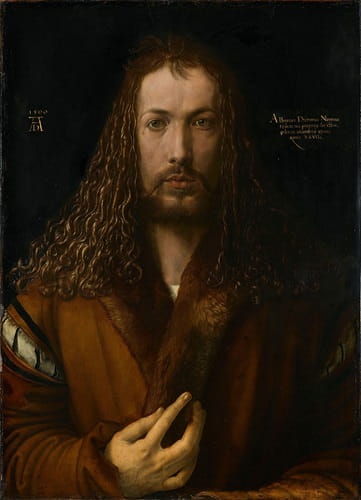
Self-Portrait at 28, 1500 by Albrecht Dürer – 10 Most Famous Self-Portraits of Art History.
Dürer‘s self-portrait at 28 is significant for several reasons. Firstly, it showcases his confidence and pride in his identity as an artist during a period when the profession was gaining recognition and respect. Secondly, the portrait captures the spirit of the Renaissance, a time of renewed interest in humanism, self-discovery, and artistic expression.
“Self-Portrait at 28” by Albrecht Dürer stands as a testament to the artist’s mastery and self-assurance. Through this painting, Durer invites viewers to contemplate the essence of identity and the power of self-representation. His ability to capture his likeness with such precision and depth elevates this artwork to the status of a timeless masterpiece, reminding us of the enduring significance of self-portraiture in the world of art.
5- Élisabeth Louise Vigée Le Brun – Self-Portrait in a Straw Hat (1782)
Élisabeth Louise Vigée Le Brun, an influential French portrait painter of the 18th century, created “Self-Portrait in a Straw Hat” in 1782. This painting is not only a masterpiece of technical skill but also a powerful statement of female empowerment and artistic independence.
In “Self-Portrait in a Straw Hat,” Vigée Le Brun presents herself with a confident and assertive demeanor. She is depicted wearing a straw hat adorned with ribbons, a symbol of rural simplicity and natural grace. Her gaze is direct and self-assured, capturing the viewer’s attention and challenging traditional gender norms of the time.

Self-Portrait in a Straw Hat, 1782 by Élisabeth Louise Vigée Le Brun – 10 Most Iconic Self-Portraits of Art History.
During the 18th century, the art world was predominantly male-dominated, and female artists faced significant challenges in establishing themselves as professionals. Vigée Le Brun, however, defied these conventions. Through her self-portrait, she portrayed herself not as a passive object but as an active, skilled artist, challenging the notion that women could only be muses or models in art.
Recommended For You – Famous Female Artists: Pioneers of the Art World
“Self-Portrait in a Straw Hat” symbolizes Vigée Le Brun‘s determination to be recognized as a professional artist. The choice of a straw hat, traditionally associated with peasants, challenges aristocratic conventions, emphasizing her down-to-earth nature and artistic authenticity.
The painting exudes an aura of self-assurance and independence, reflecting the artist’s resilience in the face of societal expectations.
4- Egon Schiele – Self-Portrait with Physalis (1912)
Egon Schiele, a prominent Austrian Expressionist painter, created “Self-Portrait with Physalis” in 1912, offering a compelling glimpse into his unique artistic style and introspective nature. This self-portrait, like much of Schiele’s work, is marked by raw emotion, bold lines, and a sense of psychological intensity.
In “Self-Portrait with Physalis,” Schiele strikingly presents himself. His figure is angular, his gaze intense, and his hands, positioned prominently, display a remarkable level of detail. The physalis, a fruit also known as the Chinese lantern, is placed near his head, adding a touch of symbolism and visual interest to the composition.

Self-Portrait with Physalis, 1912 by Egon Schiele – 10 Most Famous Self-Portraits of Art History.
Schiele’s self-portrait captures his emotional turmoil and inner complexity. His contorted posture and piercing eyes convey a sense of vulnerability and intensity, reflecting the artist’s deep introspection and psychological struggles. The use of bold, expressive lines accentuates the tension within the painting, drawing the viewer into Schiele’s emotional world.
The physalis, with its delicate yet enclosing structure, is often interpreted as a symbol of protection or confinement. Placed near Schiele’s head, it can be seen as a representation of the artist’s thoughts and emotions, encapsulated and contained.
The composition, with Schiele’s figure dominating the canvas, emphasizes his self-focus and the introspective nature of his work.
3- Gustave Courbet – The Desperate Man (Self-Portrait) (1843-1845)
Gustave Courbet, a leading figure of the 19th-century Realist movement, created “The Desperate Man” (also known as Self-Portrait) between 1843 and 1845. This intense and emotionally charged self-portrait stands as a testament to Courbet’s innovative approach to art, capturing the tumultuous inner world of the artist.

The Desperate Man, 1843-1845 by Gustave Courbet – 10 Most Famous Self-Portraits of Art History.
Recommended For You – Gustave Courbet’s Life and Art
In “The Desperate Man,” Courbet presents himself in a state of profound anguish. His disheveled hair and wild, expressive eyes convey a sense of desperation and turmoil. The painting is characterized by bold, dramatic brushstrokes, emphasizing the intensity of Courbet’s emotions. His hands clutch his head, suggesting a deep psychological struggle.
Gustave Courbet’s self-portrait is a raw and unfiltered depiction of his emotional state. The contorted expression on his face and the agitated brushwork create a sense of inner torment. The painting captures a moment of desperation, inviting viewers to witness the artist’s struggle and vulnerability. Courbet’s ability to convey such intense emotion through his art is a hallmark of his talent and artistic vision.
2- Pablo Picasso – Self-Portrait Facing Death (1972)
In the final years of his life, Pablo Picasso created a poignant self-portrait titled “Self-Portrait Facing Death” in 1972. This artwork, executed with raw emotion and introspection, offers a profound reflection on mortality and the passage of time, capturing the essence of Picasso’s legacy as an artist.
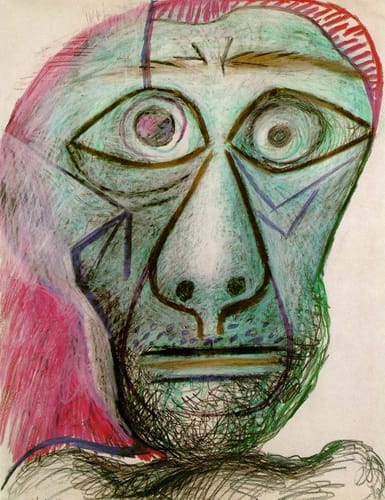
Self Portrait Facing Death, 1972 by Pablo Picasso – 10 Most Famous Self-Portraits of Art History.
“Self-Portrait Facing Death” depicts an elderly Pablo Picasso, his face etched with wrinkles and marked by the weight of years. The use of bold lines and subdued colors emphasizes the depth of his gaze, conveying a sense of acceptance and contemplation. The painting exudes a haunting beauty, capturing the artist’s resilience and wisdom in the face of mortality.
In this self-portrait, Picasso confronts his mortality with a sense of acceptance and courage. The painting serves as a meditation on life, art, and the inevitability of death. Through his piercing eyes and weathered features, Picasso communicates a lifetime of artistic exploration and introspection, inviting viewers to confront their mortality alongside him.
1- Leonardo da Vinci’s Self Portrait – Portrait of a Man in Red Chalk (1512)
“Portrait of a Man in Red Chalk” is a red chalk drawing widely attributed to Leonardo da Vinci. This artwork, believed to be created in the later years of Leonardo’s life, is a testament to his ability to capture the essence of his subjects with remarkable sensitivity and precision.
In this portrait, an unknown gentleman is depicted with meticulous detail. The subject’s face is characterized by soft, delicate features, and his expression exudes a sense of wisdom and introspection. The use of red chalk allows for subtle gradations of light and shadow, giving the drawing a three-dimensional quality. The man’s attire, especially the intricate details of his collar, adds to the overall elegance of the portrait.
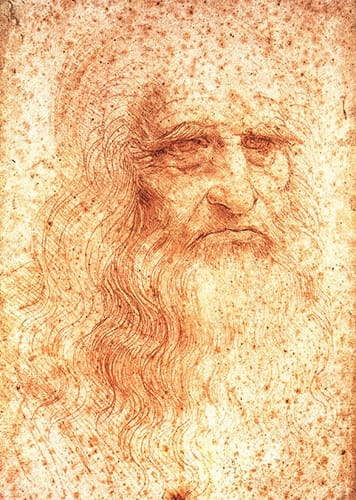
Portrait of a Man in Red Chalk, 1512 by Leonardo da Vinci – 10 Most Famous Self-Portraits of Art History.
The identity of the man in the portrait remains a mystery, adding an air of intrigue to the artwork. Over the years, art historians and scholars have speculated about the possible identity of the sitter, with suggestions ranging from a scholar or a philosopher to a member of the Medici family, who were patrons of Leonardo. Despite various theories, the true identity of the man depicted in the drawing remains unknown.
Leonardo da Vinci‘s mastery of anatomical precision and ability to convey depth and emotion is evident in this portrait. The subtle rendering of the man’s features, including his eyes and lips, showcases Leonardo’s exceptional skill in capturing the subtleties of human expression.
The red chalk medium allows for softness and warmth in the portrayal, adding to the overall intimacy of the artwork.
Self-portraits offer a profound insight into the artists’ souls, capturing their emotions, struggles, and creativity. By exploring these iconic self-portraits, we not only appreciate the technical brilliance behind the artworks but also gain a deeper understanding of the artists themselves.
Whether you’re an art enthusiast, a history buff, or someone intrigued by the human psyche, these self-portraits will continue to inspire and captivate generations to come.
References:
- https://courtauld.ac.uk/highlights/self-portrait-with-bandaged-ear/
- https://tr.wikipedia.org/wiki/Vincent_van_Gogh
- https://www.fridakahlo.org/self-portrait-with-thorn-necklace-and-hummingbird.jsp
- https://www.rembrandtpaintings.com/self-portrait-with-two-circle.jsp
- https://en.wikipedia.org/wiki/Las_Meninas
- https://en.wikipedia.org/wiki/Self-Portrait_(D%C3%BCrer,_Munich)
- https://en.wikipedia.org/wiki/Self-portrait_in_a_Straw_Hat
- https://artsandculture.google.com/asset/selbstbildnis-mit-lampionfr%C3%BCchten/lAGS1DQVHQVm6Q?hl=en-GB
- https://www.gustave-courbet.com/the-desperate-man.jsp
- https://www.artchive.com/artwork/self-portrait-facing-death-pablo-picasso-1972/
- https://www.leonardodavinci.net/self-portrait.jsp






